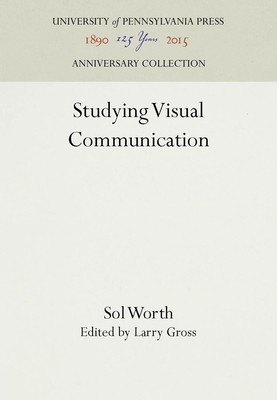
- We will send in 10–14 business days.
- Author: Sol Worth
- Publisher: University of Pennsylvania Press Anniversary Collection
- ISBN-10: 0812277910
- ISBN-13: 9780812277913
- Format: 15.5 x 23.5 x 1.4 cm, hardcover
- Language: English
- SAVE -10% with code: EXTRA
Reviews
Description
Worth had courage and originality enough not to take pictures for granted, but thought and struggled with some of the most difficult problems that cinematographers (and researchers in visual media) are faced with.--Edward T. Hall
One of the central figures in the development of the study of visual communication, Sol Worth (1922-1977) was a filmmaker and painter before he turned to academic pursuits. He began with the question of how film could be understood and studied as a medium of communication and from there he moved on to the larger and more profound questions about the nature of visual media in general and the role that visual images play in shaping and constructing reality. Worth's pioneering work with Navajo filmmakers broadened our understanding of visual perception and communication even as it presented anthropologists with a means to achieve one of their most cherished goals: somehow to see the world through the eyes of their informants.
The papers in this volume trace the development of Worth's thinking and research as he outlined the problems and issues that must be faced in the study of visual communication. He went further than anyone else in setting the intellectual agenda for the field, drawing upon such diverse disciplines as anthropology, sociology, psychology, linguistics, and semiotics. His broader interests are reflected in several papers that apply to problems and concerns of a more practical nature. Among them is Worth's innovative paper on the use of film in education.
Worth's contributions to the serious task of understanding the role and potential of visual media and visual communication extend far beyond the intellectual realms of theory and speculation. Indeed, they speak clearly to issues facing all of us in a world that is so much shaped by visual communication.
EXTRA 10 % discount with code: EXTRA
The promotion ends in 17d.11:56:42
The discount code is valid when purchasing from 10 €. Discounts do not stack.
- Author: Sol Worth
- Publisher: University of Pennsylvania Press Anniversary Collection
- ISBN-10: 0812277910
- ISBN-13: 9780812277913
- Format: 15.5 x 23.5 x 1.4 cm, hardcover
- Language: English English
Worth had courage and originality enough not to take pictures for granted, but thought and struggled with some of the most difficult problems that cinematographers (and researchers in visual media) are faced with.--Edward T. Hall
One of the central figures in the development of the study of visual communication, Sol Worth (1922-1977) was a filmmaker and painter before he turned to academic pursuits. He began with the question of how film could be understood and studied as a medium of communication and from there he moved on to the larger and more profound questions about the nature of visual media in general and the role that visual images play in shaping and constructing reality. Worth's pioneering work with Navajo filmmakers broadened our understanding of visual perception and communication even as it presented anthropologists with a means to achieve one of their most cherished goals: somehow to see the world through the eyes of their informants.
The papers in this volume trace the development of Worth's thinking and research as he outlined the problems and issues that must be faced in the study of visual communication. He went further than anyone else in setting the intellectual agenda for the field, drawing upon such diverse disciplines as anthropology, sociology, psychology, linguistics, and semiotics. His broader interests are reflected in several papers that apply to problems and concerns of a more practical nature. Among them is Worth's innovative paper on the use of film in education.
Worth's contributions to the serious task of understanding the role and potential of visual media and visual communication extend far beyond the intellectual realms of theory and speculation. Indeed, they speak clearly to issues facing all of us in a world that is so much shaped by visual communication.


Reviews